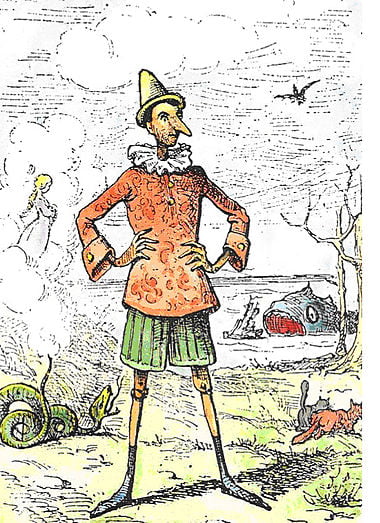The Adventures of Pinocchio (/pɪˈnoʊki.oʊ/ pi-NOH-kee-oh; Italian: Le avventure di Pinocchio [le avvenˈtuːre di piˈnɔkkjo]; commonly shortened to Pinocchio) is a novel for children by Italian author Carlo Collodi, written in Pescia. It is about the mischievous adventures of an animated marionette named Pinocchio and his father, a poor woodcarver named Geppetto.
It was originally published in a serial form as The Story of a Puppet (Italian: La storia di un burattino) in the Giornale per i bambini, one of the earliest Italian weekly magazines for children, starting from 7 July 1881. The story stopped after nearly 4 months and 8 episodes at Chapter 15, but by popular demand from readers, the episodes were resumed on 16 February 1882.[1] In February 1883, the story was published in a single book. Since then, the spread of Pinocchio on the main markets for children’s books of the time has been continuous and uninterrupted, and it was met with enthusiastic reviews worldwide.[1]
A universal icon and a metaphor of the human condition, the book is considered a canonical piece of children’s literature and has had great impact on world culture. Philosopher Benedetto Croce reputed it as one of the greatest works of Italian literature.[2] Since its first publication, it has inspired hundreds of new editions, stage plays, merchandising, television series and movies, such as Walt Disney‘s iconic animated version, and commonplace ideas such as a liar’s long nose.
According to extensive research by the Fondazione Nazionale Carlo Collodi and UNESCO sources in the late 1990s, the book has been translated into as many as 260 languages worldwide,[3][4] making it one of the world’s most translated books.[3] Likely one of the best-selling books ever published, the actual total sales since first being published are unknown due to the many reductions and different versions.[3] The story has been a public domain work in the U.S. since 1940. According to Viero Peroncini: “some sources report 35 million [copies sold], others 80, but it is only a way, even a rather idle one, of quantifying an unquantifiable success”.[5] According to Francelia Butler, it also remains “the most translated Italian book and, after the Bible, the most widely read”.[6]




